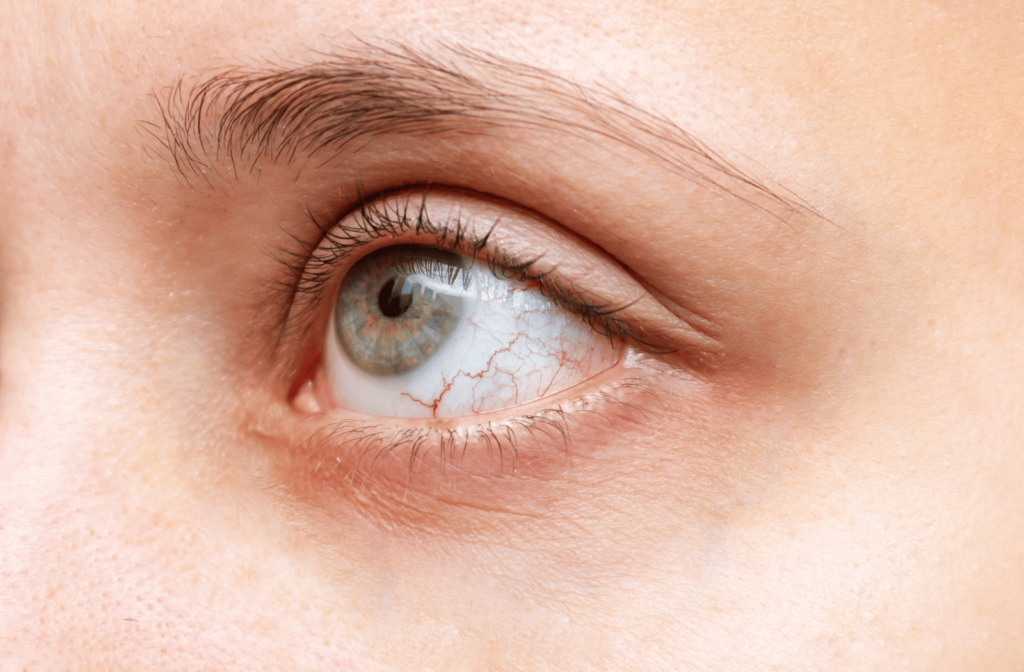The problem of dry eye disease is quite common and persistent, particularly among older individuals. Our eyes are lubricated by tears that spread across the cornea, which is the front surface of the eye, every time we blink.
These tears are crucial for protecting our eyes from infections, eliminating foreign matter, and keeping the surface of our eyes smooth and clear.
When tear production and drainage are not in balance, it can result in the development of dry eye disease.
If you are experiencing dry eye symptoms, it is important to consult with your eye doctor for proper guidance and treatment.
Symptoms of Dry Eye Disease
Symptoms of dry eye disease may include:
- Dryness in the eyes
- Irritation or scratchiness
- Burning sensation
- Redness
- Sensitivity to light
- Watery eyes
- Blurry vision
- Eye fatigue or discomfort
- Feeling like there is something in the eye
- Difficulty wearing contact lenses
Dry Eye Causes & Risk Factors
There are numerous causes of dry eyes, encompassing many factors. One major contributor is age, as tear production tends to decrease as we get older. Hormonal changes occur particularly in women after menopause.
Additionally, environmental factors play a significant role, such as living in areas with low humidity or high winds.
Exposure to air pollutants or smoke, whether from cigarettes or fires, can also contribute to dry eyes. Certain medications, such as antihistamines, antidepressants, and birth control pills, have been known to have an impact as well.
Furthermore, specific health conditions, including diabetes, Sjogren’s syndrome, rheumatoid arthritis, lupus, thyroid problems, and vitamin A deficiency, can lead to dry eyes.
A dry, indoor environment or ill-fitting contacts can also lead to dry eye disease.
If you’re experiencing any of these symptoms or suspect that you may have dry eye disease, it’s recommended to consult your doctor for a proper diagnosis. Various treatment options are available to address this condition and alleviate the associated discomfort.
How Does Dry Eye Disease Affect Your Eyes?
The human eye is a delicate and intricate organ requiring constant care and attention. The tear film, which is responsible for keeping our eyes healthy and moisturized, comprises 3 distinct layers, each playing a crucial role in maintaining our ocular health.
The top layer, consisting of oil, smooths the tear surface and prevents rapid evaporation. However, conditions such as blepharitis or rosacea can cause blockages in the meibomian glands that produce this oil, leading to dry eyes.
The middle layer, the thickest of the 3, is primarily composed of water and salt, which serve to cleanse the eyes of particles and irritants. Tear instability and a stringy discharge are common symptoms of dry eyes related to issues with this layer.
Finally, the innermost layer is made up of mucus, which facilitates the even spread of tears across the eye. When issues arise with this layer, dry patches may form on the cornea, the clear membrane located in front of the iris and pupil.
A variety of factors can contribute to the development of dry eye, including prolonged computer use, exposure to smoke or dry climates, and wearing contact lenses. Other factors, such as aging, certain medical conditions, and treatments like chemotherapy and radiation therapy, can also increase the risk of developing this uncomfortable condition.
Treating Dry Eye Disease
The treatment of dry eye disease depends on the severity of the condition, as well as individual factors such as age and medical history. Options may include artificial tears, ointments, dietary supplements, lifestyle changes, and, in some cases, medications or surgery. It is important to note that while these treatments may provide relief, they do not necessarily cure dry eye disease.
Diagnosis of Dry Eye Disease
Diagnosing Tools & Tests
Dry eye syndrome is a common condition that can cause discomfort and vision problems. Tests to diagnose dry eye may include visual acuity measurement, slit lamp exam, diagnostic staining of the cornea and tear film, measurement of tear film break-up time (TBUT), measurement of the rate of tear production (Schirmer test), and measurement of the concentration of tears (osmolality).
Artificial Tears & Punctal Plugs
Fortunately, there are various treatment options available. The first step is to use artificial tears, which come in preserved and unpreserved forms. If symptoms persist, individuals may need to increase their use of these drops, switch to unpreserved drops, try a different brand, or consider prescription medications or tiny plugs that help to retain moisture in the eyes.
Alternative Dry Eye Treatments
Other treatments include punicalagins (potent anti-oxidants,) omega fatty acids, and light therapy. In some cases, surgery may be required to treat more serious conditions such as entropion (where the eyelid flips inward) or ectropion (where the eyelid flips outward.) With proper care and treatment, most dry eye symptoms can be managed, and the condition can be improved.
Tips to Improve Conditions
Other helpful steps to manage dry eye symptoms include avoiding smoke and second-hand smoke, using a humidifier, limiting allergy and cold medications that may dry out the eyes, purposefully blinking more often, regularly cleaning eyelashes, and applying warm compresses. In some cases, surgery may be necessary to address underlying eyelid abnormalities.
There Is Hope for Dry Eye Relief
Though you may be suffering from dry eyes, plenty of options exist. Sometimes, it’s as simple as a medication change, and artificial tears may be enough for others. If you have any further questions or want to discuss your dry eye treatment options, please contact us.
The Eye Care Team offers personalized care and attention that is tailored to your individual needs. We are dedicated to providing quality care for our patients, and we look forward to helping you achieve clear vision and improved eye health. Book your appointment in Spokane or Chewelah, Washington, today.



